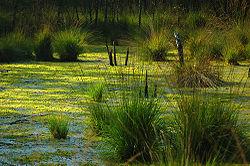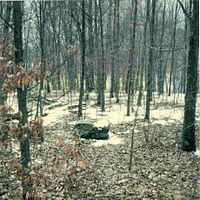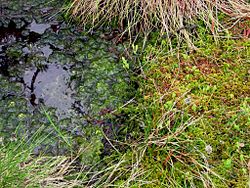
Bog
About this schools Wikipedia selection
This content from Wikipedia has been selected by SOS Children for suitability in schools around the world. SOS Children is the world's largest charity giving orphaned and abandoned children the chance of family life.

A bog or mire is a wetland type that accumulates acidic peat, a deposit of dead plant material – usually mosses, but also lichens in Arctic climates. Bogs occur where the water at the ground surface is acidic, either from acidic ground water, or where water is derived entirely from precipitation, when they are termed ombrotrophic (rain-fed). Water flowing out of bogs has a characteristic brown colour, from dissolved peat tannins. Bogs are very sensitive habitats, of high importance for biodiversity.
Distribution and extent
Bogs are widely distributed in cold, temperate climes, mostly in the northern hemisphere ( Boreal). The world's largest wetlands are the bogs of the Western Siberian Lowlands in Russia, which cover more than 600,000 square kilometres. Sphagnum bogs were widespread in northern Europe. Ireland was more than 15% bog; Achill Island off Ireland is 87% bog. There are extensive bogs in Canada and Alaska (called muskeg), Scotland, Denmark, Estonia (20% bog lands), Finland (26%), northern Germany, the Netherlands, Ireland, and Sweden. There are also bogs in the Falkland Islands. Ombrotrophic wetlands (of which bogs are an example) are also found in the tropics, with notable areas documented in Kalimantan; these habitats are forested so would be better called acidic swamps. Extensive bogs cover the northern areas of the U.S. states of Minnesota and Michigan, most notably on Isle Royale in Lake Superior. The pocosin of the southeastern United States is like a bog in that it is an acidic wetland but it has its own unusual combination of features. In certain areas such as Ireland and Scotland, coastal bogs are frequently intruded upon by low lying dunes called Machairs.
Types of bog
Bog habitats may develop in various situations, depending on the climate and topography. The main types are:
Valley bog
These develop in gently sloping valleys or hollows. A layer of peat fills the deepest part of the valley, and a stream may run through the surface of the bog. Valley bogs may develop in relatively dry and warm climates, but because they rely on ground or surface water, they only occur on acidic substrates.
Raised bog
These develop from a lake or flat marshy area, over either non-acidic or acidic substrates. Over centuries there is a progression from open lake, to marsh and then fen (or on acidic substrates, valley bog), as silt or peat fill the lake. Eventually peat builds up to a level where the land surface is too flat for ground or surface water to reach the centre of the wetland. This part therefore becomes wholly rain-fed ( ombrotrophic), and the resulting acidic conditions allow the development of bog (even if the substrate is non-acidic). The bog continues to form peat, and over time a shallow dome of bog peat develops: a raised bog. The dome is typically a few meters high in the centre, and is often surrounded by strips of fen or other wetland vegetation at the edges or along streamsides, where ground water can percolate into the wetland.
Blanket bog
In cool climates with consistently high rainfall, the ground surface may remain waterlogged for much of the time, providing conditions for the development of bog vegetation. In these circumstances bog develops as a layer "blanketing" much of the land, including hilltops and slopes. Although blanket bog is more common on acidic substrates, under some conditions it may also develop on neutral or even alkaline ones, if abundant acidic rainwater predominates over the ground water. Blanket bog cannot occur in drier or warmer climates, because under those conditions hilltops and sloping ground dry out too often for peat to form; in intermediate climates blanket bog may be limited to slopes which do not get direct sunshine. In periglacial climates a patterned form of blanket bog may occur: string bog.
Quaking bog
Quaking bog or schwingmoor is a form of bog occurring in wetter parts of valley bogs and raised bogs, and sometimes around the edges of acidic lakes where bog is beginning to form. The bog vegetation forms a mat half a meter or so thick, floating over water or very wet peat. Walking on this surface causes it to move – larger movements may cause visible ripples of the surface, or they may even make trees sway.
Bog habitats
Bogs are recognized as a significant habitat type by a number of governmental and conservation agencies. For example, the United Kingdom in its Biodiversity Action Plan establishes bog habitats as a priority for conservation. Bogs are challenging environments for plant life because they are low in nutrients and very acidic. Carnivorous plants have adapted to these conditions by using insects as a nutrient source. The high acidity of bogs and the absorption of water by sphagnum moss reduce the amount of water available for plants. Some bog plants, such as Leatherleaf, have waxy leaves to help retain moisture. Bogs also offer a unique environment for animals. For instance, English bogs give a home to the boghopper beetle and a yellow fly called the hairy canary fly.
Uses
Industrial uses
A bog is a very early stage in the formation of coal deposits. In fact, bogs can catch fire and often sustain long-lasting smoldering blazes, producing smoke and carbon dioxide, thus causing health and environmental problems. After drying, peat is used as a fuel. More than 20% of home heat in Ireland comes from peat, and it is also used for fuel in Finland, Scotland, Germany, and Russia. Russia is the leading extractor of peat for fuel at more than 90 million metric tons per year. Ireland's Bord na Móna ("peat board") was one of the first companies to mechanically harvest peat.
The other major use of dried peat is as a soil amendment (sold as moss peat or sphagnum peat) to increase the soil's capacity to retain moisture and enrich the soil. It is also used as a mulch. Some distilleries, notably Laphroaig, use peat fires to smoke the barley used in making Scotch whisky. More than 90% of the bogs in England have been destroyed.
Other uses
Blueberries, cranberries, cloudberries, huckleberries and lingonberries are harvested from the wild in bogs. Bog oak, wood that has been partially preserved by bogs, has been used in manufacture of furniture.
Sphagnum bogs are also used for sport, but this can be damaging. All-terrain vehicles are especially damaging to bogs. Bog snorkeling is popular in England and Wales. Llanwrtyd Wells, the smallest town in Wales, hosts the World Bog Snorkeling Championships. In this event, competitors with mask, snorkel, and scuba fins swim along a 60-meter trench cut through a peat bog.
Archaeology
The anaerobic environment and presence of tannic acids within bogs can result in the remarkable preservation of organic material. Finds of such material have been made in Denmark, Germany, Ireland and the United Kingdom. Some bogs have preserved ancient oak logs useful in dendrochronology, and they have yielded extremely well-preserved bog bodies, with organs, skin, and hair intact, buried there thousands of years ago after apparent Germanic and Celtic human sacrifice. Excellent examples of such human specimens are Haraldskær Woman and Tollund Man in Denmark, and Lindow man found at Lindow Common in England. At Ceide Fields in County Mayo in Ireland, a 5000 year old neolithic farming landscape has been found preserved under a blanket bog, complete with field walls and hut sites. One ancient artefact found in bogs in many places is bog butter, large masses of fat, usually in wooden containers. These are thought to have been food stores, of both butter and tallow.
Fiction and song
Gothic Fiction is commonly set on a moor, a type of landscape common in Great Britain and Ireland which often has extensive bogs. One example is " The Hound of the Baskervilles", a Sherlock Holmes story by Arthur Conan Doyle which is largely set on Dartmoor and contains the fictional bog Grimpen Mire, said to have been based on Fox Tor in Devon.
Several comic book characters are based on the idea of a half-plant/half-human creature living in a bog, notably The Heap, Swamp Thing, Man-Thing, and Solomon Grundy.
German industrial band Bigod 20 had their biggest hit with 1990s "The Bog", in which the narrator, a fell creature living within the bog (or perhaps the bog itself), describes how he's swallowing the listener's body. American post-punk band be your own PET also has a song called "Bog", where the singer mentions having drowned her boyfriend in a bog.
One of Europe's best-known protest songs, " Peat Bog Soldiers", was written by prisoners in Nazi moorland labour camps in the Emsland and describes their penal labour in bog drainage.


